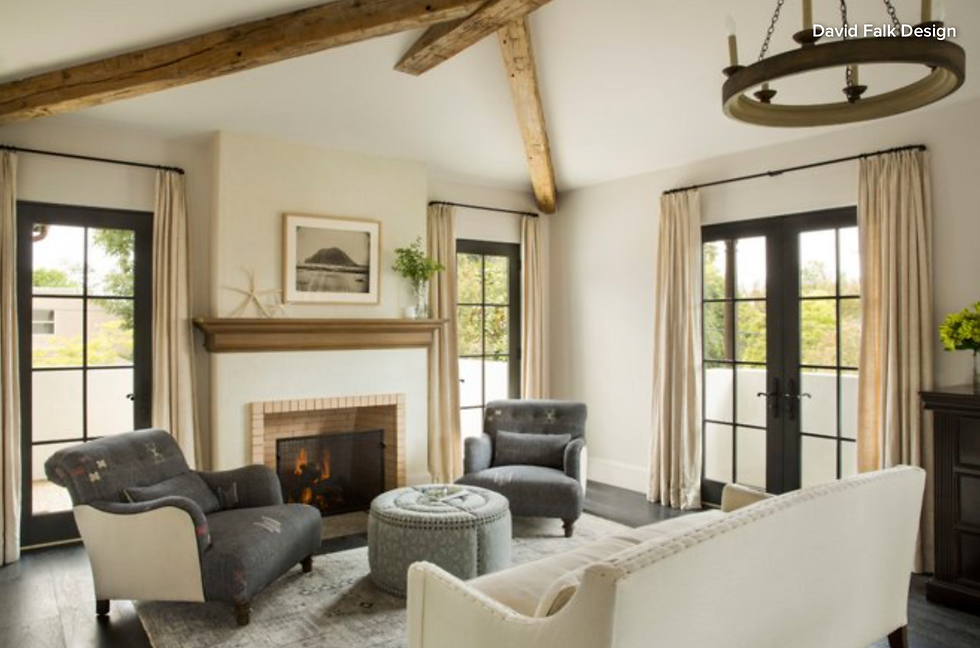Your Guide to Mediterranean Style
- The PJ Team

- Aug 20, 2019
- 3 min read
Achieve the warmth and elegance of this style with key elements, palettes, furniture and accessories
Having a good sense of your favorite style can be a great help, whether you’re working with a designer or shopping for decor. If you love a casually elegant, earthy look inspired by the sun and sea, Mediterranean style may be the right decorating matchup for you. Read on for the need-to-know details about this popular style, including key elements, color palettes, furniture and accessories.

What Is Mediterranean Style?
With roots in countries spanning the Mediterranean region — including Spain, Greece, Italy, France and Morocco, to name a few — this style is as diverse as the area it springs from. Mediterranean-style spaces can be cool and breezy or rich and warm, calling to mind sun-drenched land and sparkling water. Hallmarks of the look include smooth expanses of cool white plaster, dark wood beams, rich textiles and intricate tilework.
Mediterranean style is:
Cool and refreshing. Whitewashed walls, tile floors and stone offer a cooling respite in a warm climate.
Earthy. Look for natural materials like rough-hewn wood, leather, terra cotta and stone.
Ornamented. Mediterranean style embraces the art of surface ornamentation with elaborate tilework, ceramics and richly patterned textiles, as well as intricately carved wood.
Mediterranean style is not:
Trendy. While Mediterranean-style spaces can incorporate contemporary touches, the look as a whole is about classics that have stood the test of time.
Fussy. Mediterranean style can be formal, but it never sacrifices comfort or ease. Think of breezy spaces made for indoor-outdoor living.
Mass-produced. The emphasis is on earthy warmth, with natural materials and handmade items playing a major role. An overabundance of modern plastics would look out of place in a Mediterranean home.
Design Twist: Modern Mediterranean
If you love Mediterranean style but don’t live in a Spanish-style home (or just want a hint of Mediterranean flavor), it’s possible to find a middle way. In this kitchen from Christine Kimberlee Designs, crisp details like Shaker-style cabinets and sleek stools pair with a colorful tile backsplash and pendant lights with an arabesque design for a modern twist on Mediterranean style.
Key Element: Rich, Earthy Palette
Mediterranean homes tend toward rich colors that look pulled directly from nature — especially the warm earth and the sparkling sea. These rich, earthy hues have the greatest impact when placed against a calming backdrop of white and natural wood.
Great shades for Mediterranean-style spaces:
Neutral backdrop. Alabaster, parchment, straw, stone
Warm and earthy. Clay, cinnamon, chile pepper, flax, umber, bougainvillea, terra cotta
Oceanic. Azure, cerulean, cobalt, turquoise, moss, sea green
Key Element: Colorful Tile
Whether on floors, stair risers, a patio or a kitchen backsplash, colorful tile is a must in Mediterranean spaces. Look for hand-painted patterned tile, or work with a pro to create a design using solid-colored tiles in geometric shapes.
Key Element: Heirloom-Quality Classics
Furnishings and accessories in Mediterranean-style spaces are big, sturdy and built to last. Classic pieces are favored over passing trends, with natural materials like carved wood, wrought iron and leather taking a starring role. Upholstery tends to be richly textured and solid in color, with patterns coming into play in accent pieces, pillows and rugs.
Finishing Touches: Color and Pattern
Mediterranean-style spaces often have a simple backdrop of white walls and wood floors, which makes the finishing touches you choose to complete the look all the more important. Look for textiles to layer, inlaid and tile-inspired designs and handmade or antique accent pieces.
Accessories for Mediterranean spaces:
Moroccan-style or inlaid-bone mirrors
Layered rugs in rich hues
Pillows covered in lush textiles such as damask, brocade, silk and velvet
Rich leather accent chairs
Handmade or antique decorative objects in ceramic, wood or metal filigree
Fresh green plants in colorful ceramic or terra-cotta pots
Mediterranean Kitchen Design
Warm and welcoming, Mediterranean kitchens highlight natural materials such as wood, brick and stone. And while traditionally Mediterranean kitchens have tended toward warm hues and heavy wrought iron details, today’s iterations often take a lighter approach, with plenty of white space to offset the rich tilework and natural wood.
Features of Mediterranean kitchens:
Colorful tile. Decorative tile can be used as a backsplash, on an island or on the floor.
Black hardware. Examples include traditional wrought iron or simple drawer pulls in black, for a more modern look. Reclaimed wood. Richly textured reclaimed wood can be used as an accent or in a bolder application, such as exposed beams.
Natural materials. Look for leather island stools, natural wood, brick and stone.
Open shelving. Lighten up a Mediterranean kitchen by replacing some upper cabinets with open shelving to display pottery.
Mediterranean Bathroom Design
Many of the features that give Mediterranean kitchens their warm, inviting look work well in the bathroom too. This Mediterranean-style bathroom by Jessica Helgerson Interior Design is a good example, with patterned tile floors, white walls, a wooden bench and a bold black freestanding tub.
Your turn: Are you a fan of Mediterranean style? Describe or show us your favorite Mediterranean-style space in the Comments.
Laura Gaskill August 14, 2019




Comments